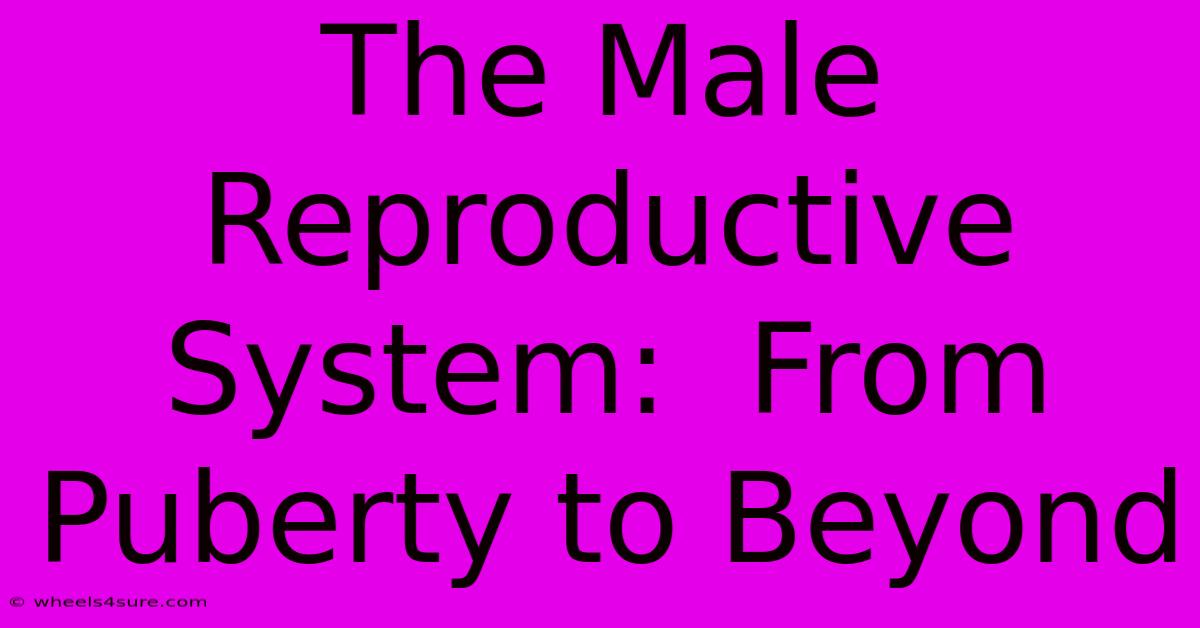The Male Reproductive System: From Puberty To Beyond

Table of Contents
The Male Reproductive System: From Puberty to Beyond
The male reproductive system is a complex and fascinating network responsible for producing and delivering sperm, enabling human reproduction. Understanding its function throughout a man's life, from puberty to beyond, is crucial for maintaining health and well-being. This comprehensive guide explores the key stages and components of this vital system.
Puberty: The Onset of Reproductive Function
Puberty marks the beginning of sexual maturation in males, typically starting between the ages of 10 and 16. This period is characterized by significant hormonal changes, primarily driven by the hypothalamus, pituitary gland, and testes. These hormonal shifts trigger several key developments:
-
Increased Testosterone Production: The testes begin producing significantly more testosterone, a steroid hormone crucial for the development of secondary sexual characteristics and the maturation of sperm production.
-
Development of Secondary Sexual Characteristics: Testosterone fuels the development of physical traits like increased muscle mass, growth of facial and body hair, deepening of the voice, and the growth of the penis and testes.
-
Spermatogenesis: This process, the production of sperm, commences and continues throughout a man's reproductive years. Millions of sperm are produced daily within the seminiferous tubules of the testes.
-
Growth Spurt: A significant increase in height and weight occurs during puberty, largely influenced by testosterone and other growth hormones.
Understanding the Key Players
Several organs work in concert to ensure the proper functioning of the male reproductive system during puberty and beyond:
-
Testes (Testicles): These are the primary male reproductive organs, producing sperm and testosterone.
-
Epididymis: A coiled tube where sperm mature and are stored.
-
Vas Deferens: A duct that transports mature sperm from the epididymis to the ejaculatory duct.
-
Seminal Vesicles: Glands that produce a fluid rich in fructose, providing energy for sperm.
-
Prostate Gland: A gland that contributes an alkaline fluid to semen, helping to neutralize the acidity of the vagina.
-
Bulbourethral Glands (Cowper's Glands): These glands secrete a pre-ejaculatory fluid that lubricates the urethra.
-
Penis: The male sexual organ involved in sexual intercourse and urination.
-
Scrotum: The sac that holds the testes, maintaining a temperature slightly lower than body temperature, essential for sperm production.
Maintaining Reproductive Health Throughout Adulthood
Maintaining a healthy lifestyle is crucial for optimal reproductive function throughout adulthood. This involves:
-
Regular Exercise: Physical activity improves overall health and can positively impact sexual function.
-
Balanced Diet: A diet rich in fruits, vegetables, and whole grains supports overall health, including reproductive health.
-
Stress Management: Chronic stress can negatively affect hormone levels and sexual function.
-
Regular Checkups: Routine medical checkups, including prostate exams and blood tests, can detect potential problems early on.
Beyond Peak Fertility: Changes in Later Life
As men age, testosterone levels gradually decline, a process known as andropause. This can lead to changes in:
-
Libido: Sexual desire may decrease.
-
Erectile Function: Erections may become less frequent or less firm.
-
Sperm Production: Sperm count and quality may decline.
However, it's important to note that many men remain sexually active and fertile well into their later years. While some age-related changes are inevitable, maintaining a healthy lifestyle can help mitigate their impact.
Common Issues Affecting the Male Reproductive System
Several issues can affect the male reproductive system at various life stages, including:
-
Infertility: The inability to conceive a child. This can result from various factors affecting sperm production, transport, or the overall reproductive system.
-
Prostate Cancer: A common cancer in older men, often affecting the prostate gland.
-
Erectile Dysfunction: The inability to achieve or maintain an erection sufficient for sexual intercourse.
-
Testicular Cancer: A relatively rare but potentially serious cancer affecting the testes. Early detection is crucial for successful treatment.
Conclusion:
The male reproductive system undergoes significant changes throughout a man's life, from the onset of puberty to later years. Understanding these changes, maintaining a healthy lifestyle, and seeking medical attention when needed are essential for preserving reproductive health and well-being. Early detection and treatment of potential problems are crucial for maximizing reproductive health and overall quality of life.

Thank you for visiting our website wich cover about The Male Reproductive System: From Puberty To Beyond. We hope the information provided has been useful to you. Feel free to contact us if you have any questions or need further assistance. See you next time and dont miss to bookmark.
Featured Posts
-
Unveiling The Mystery Paul Mersons Son
Apr 03, 2025
-
What Makes Mrs Lowry And Son So Special
Apr 03, 2025
-
Daughter In Hindi A Bridge Between Generations And Cultures
Apr 03, 2025
-
The Son Suk Ku Interview You Ve Been Waiting For
Apr 03, 2025
-
Vedang Rainas Dad A Fathers Remarkable Journey
Apr 03, 2025
